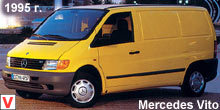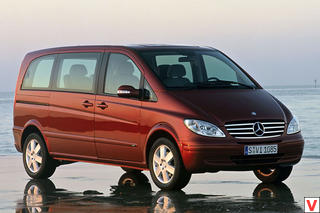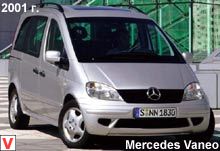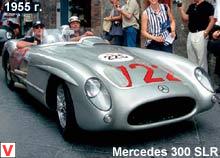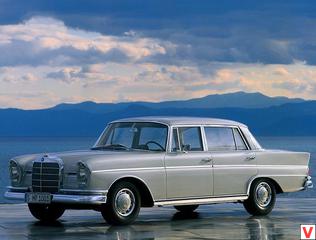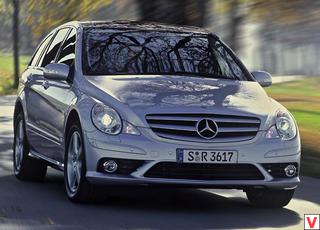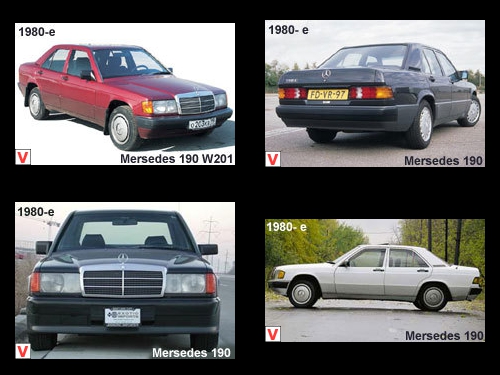
The Mersedes 190 is a four-seat mid-range sedan of the W201 series. Domestic consumers have named the car one hundred and ninetieth because of the most common 2-liter (petrol and diesel) modifications, the trunk lid of which was decorated with the 190 label. This denoted the encrypted volume of the engine (1985 cm3), which the manufacturers rounded down.
Mercedes 190 debuted in November 1982 and immediately received the nickname “baby-Benz”, because at that time it was the smallest Mercedes. Production of the Mercedes 190 (at the rate of 100,000 cars per year) began in Sindelfingen, on the same line of the conveyor where W123 was assembled. With the advent of Mercedes in the back of the W201, Mercedes-Benz took over the prestige of prestige in the European D segment and began to compete closely with the famous “3rd” BMW series.
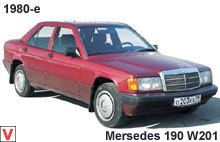
Reducing the length of the body by 300 mm in comparison with traditional sedans Mercedes-Benz W123 and the use of new light alloys allowed to win 160 kg curb weight. The four-door sedan received (for the first time for Mercedes-Benz) a wedge-shaped silhouette, glass and doors flush with the surface and lining instead of roof gutters, which reduced the drag coefficient Cx to 0.33 and in turn, significantly reduced fuel consumption. The forms that the body of the smallest Mercedes received have undoubted advantages, despite the fact that they were subjected to certain criticism due to the conservatism of the W201 developers.
Over time, such a design becomes what is rightly called a classic: clarity of forms gives the impression of rigor and sophistication. On the high-quality paintwork and anti-corrosion coating of the body, the high resistance of the W201 series cars against rust, which allows the car to maintain a decent appearance even after 20 years. However, the body of the 190th has several weak points: the trunk, into which water gets through the untight rear light seals, the lower edge of the doors in dorestaylingovyh versions (later the lower parts of the body were dressed in a wide protective plastic lining) and the hood around the front headlights.
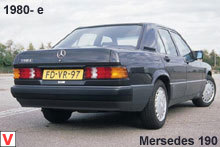
The strict and democratic interior is designed in the company's corporate style. Once inside, you have no doubt that this is a Mercedes-Benz. However, the straight front panel, large steering wheel and round dial gauges (speedometer, tachometer, fuel gauge, coolant temperature, oil pressure and econometer) without any special frills may seem too strict.
The center console is extremely laconic, and the wide front seats are more like ordinary home armchairs, wide, without a hint of lateral and lumbar support. Although it should still be noted that after the modernization of 1988, the shape of the seats has improved significantly. It is also worth paying attention that in the back seat W201 can normally accommodate only two passengers. The three of them will be cramped, and there is clearly little room for legs behind. But the heating system deserves praise. The stove allows the driver and the front passenger to individually control the temperature of the supplied air.

The luggage compartment of the hundred ninety is not very capacious, its volume is 410 liters, whereas the main competitor of the BMW 3-series (E30) has 425 liters. From the other cars of the early 80s, the Mercedes 190 is distinguished by a high degree of active and passive safety. From the very beginning of production, the 190th equipped ABS disc brakes (front and rear) brakes, but only as additional equipment.
A very convenient multifunctional light switch and “janitors” can also be considered as one of the means of ensuring security, especially when its reliability and functionality are such that they can ignore it. The 190th is the only one of all the models of the Mercedes-Benz of the 80s, which is equipped with the traditional manual drive of the parking brake. On all other versions, it is involved with the help of a floor pedal. The suspension of all Mercedes-Benz has a great smoothness.

However, the 190th is the first Mercedes to be equipped with an independent five-arm rear suspension, which made it possible to achieve high driving comfort and good cornering, so that the driver and his passengers give a deceptive impression that our roads are not so bad. as they are painted. Daimler-Benz has always made every effort to correct these shortcomings inherent in the classic layout, and as a result of extensive research, he equipped the W201 series with a complex, five-link independent rear suspension and the Mercedes 190 steering system ensures high precision control and the absence of shock loads transmitted to the steering wheel when driving irregularities.
In addition, most modifications are equipped with a hydraulic booster. However, with time in the steering mechanism there is a backlash, which can be fixed for a while with the help of an adjusting screw. On average, the steering mechanism is able to serve up to 250 thousand km.
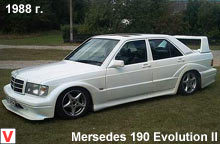
Initially, the 190th was equipped only with 2.0-liter four-cylinder petrol engines M102.921 (90-hp carburetor) - model 190, and also M102.961 (122-hp injector) - model 190E. These units were offered with a 5-speed manual gearbox or a 4-band “automatic”. In September 1983, the 190D premiered at the Frankfurt Motor Show with a 2.0-liter, 75-horsepower economical diesel engine OM601.911, which immediately became popular among taxi drivers.
A high-speed auto competitor BMW was opposed to a charged version of the 190E 2.3-16V with an expressive 185-horsepower 16-valve M102.983 engine, which accelerates the 1.5-ton sports sedan to 225 km / h and allows the hundred-kilometer barrier to be taken in 7.5 seconds. It was on this machine in the summer of 1983 that the world record was set on the ring road in Nardo. This version is distinguished by the development of aerodynamic bumpers and sills, a spoiler on the trunk lid, low-profile tires 205/55 ZR15 and more strict trim, without wooden inserts. The dynamic qualities of Mercedes-Benz models are well known to all.
but we must not forget about their tendency to excessive demolition of the rear axle when cornering on slippery roads and a non-straight run. By September 1984, the power of the 2.0-liter carburetor engine M102.924 raised to 105 hp Inline 5-cylinder diesel OM602.911 of 90 hp, which was installed on the Mercedes-Benz 190 D 2.5 from May 1985, was not only speedy (174 km / h), but also economical. The fuel consumption in the urban cycle still rarely exceeds 9 l / 100 km for new engines.
At the same time, an active telescopic “janitor” began to be installed on the “190th”, which significantly increased the area of glass cleaning (it can be distinguished by the leash on the left side), and 15-inch wheels. Engine M102.962 significantly upgraded: there was a one-time drive of attachments and hydraulic valve tappets. Since 1985, all petrol versions of the Mercedes-Benz 190 have been equipped with exhaust gas catalytic converters. At the same time, the W201 series was equipped with a 2.3-liter 132-horsepower M102.985 engine and a six-cylinder 160-horsepower M103.942.
In October 1985, in Frankfurt, rolled out the version with a six-row (2.6 liters, injection, 166 hp) and a Mercedes 190D 2.5 with a 5-cylinder 90-horsepower diesel engine. In 1986, a 190E 2.6 ASD modification was presented at an exhibition in Paris, equipped with a self-locking differential with a hydraulic drive and an actuator in the form of multi-plate “packages” of couplings. In September 1988, the model range was upgraded: the body of the W201 received a wide plastic protective cover on the bottom of the doors, modified bumpers and improved seats.
Charged sports model 190E with 2, The 3 liter 16-valve engine replaced the 190E with a 16-valve engine, but more extreme and perfect 2.5-liter 195-horsepower M102.990 engine. The most powerful alternative version at the same time was the 190D 2.5 Turbo with a 122-horsepower turbodiesel (OM602.961) and additional cuts in the right front wing to improve air flow. Then a millionth "one hundred and ninetieth" came off the assembly line ... A year later a special model appeared in the Sportline with a sports suspension (more rigid and with reduced clearance), and also with anatomical seats (only as an option).
In April 1990, an important event occurred - the abandonment of the carburetor in favor of the injection. The concern has released the most "subcompact" 109-strong version of the 190E 1.8 with the 1.8-liter M102.910 engine, which supplanted the carburetor model 190. Since January 1991, all models of the Mercedes-Benz W201 family have started to equip the ABS already in the standard configuration, and since October 1992 - and the central lock of locks, which was by no means superfluous, since many competitors have already come close to the level of performance and equipment which offered on their models (as standard) Mercedes-Benz.
In 1992, Mercedes-Benz proposed the concept of car trim Lines, for the "one hundred and ninetieth" offered three design options: Azurro, Rosso, Verde. In May 1993, the Mercedes-Benz W201 changed the new generation of cars - the C-class with the body index W220. October 14, 1993 the last Mercedes 190 silver in color straight from the assembly line went to the factory museum. In total, the company produced 1,879,630 cars with a body W201 ... In motorsports, the Mercedes 190 debuted on May 12, 1984, at the wheel of a car with 2, 3 l 16-valve engine power 185 hp was Ayrton Senna. "One hundred and ninetieth" participated in the DTM Cup - won 50 times.
The sporting success prompted the release of the “charged” version of the Evolution II to the market (spring 1990), the main external differences of which were the aerodynamic “skirt” and the huge rear wing. The car was equipped with a 2.5 liter 16-valve engine, a forced workshop AMG to 373 hp. - for DTM racing. The motor of the serial Evolution II developed 234 hp at 7200 rpm In general, one hundred and ninetieth is a good and high-quality car, designed not for one hundred thousand kilometers. In the domestic market, the so-called Baby-Benz of the first generation (ie, the 190th) has long deserved respect for its enviable strength, durability and reliability.
Only cars of the first half of the 1980s begin to rust, and then corrosion only by small foci appears on the lower surfaces of the doors. In this regard, the 190th always remained head and shoulders above rivals. We note that the confident driver of the Mercedes 190 can feel on dry pavement. Even the use of a complex five-arm rear suspension did not allow to compensate for the disadvantages of the rear-wheel drive in terms of handling on slippery surfaces. Hence: oversteer, accompanied by the demolition of the rear axle, and some complaints about the non-linear run of the car.
As for the engines, they are all durable and, on average, with normal operation they can go up to 600 thousand km, and diesel engines are generally considered to be one million people. Of the gearboxes with which the 190s were equipped (these are 4- or 5-speed manual gearboxes and 4-speed “automatic machines”), mechanical boxes are considered to be more reliable, since the automatic transmission often leaks oil, and the operation of the box with an insufficient level of lubricant leads to its breakage. But, despite these moments, in the issue of "vitality", as shown by operating experience with us, the Mercedes 190 was head and shoulders above the rest of classmates.
